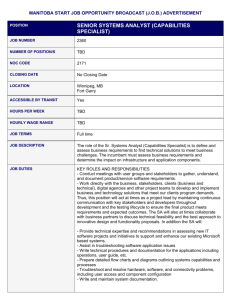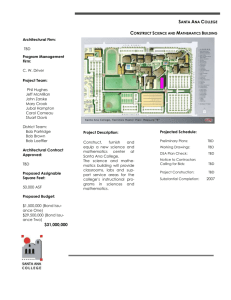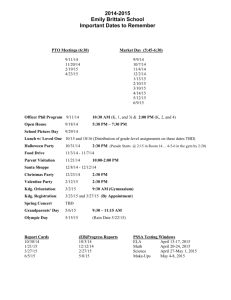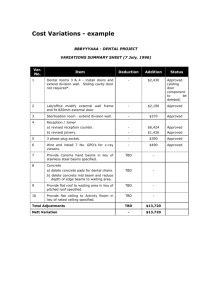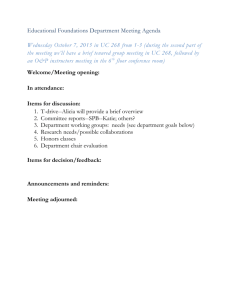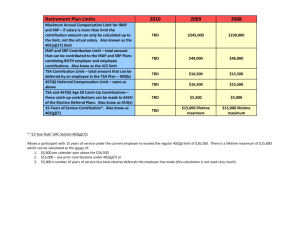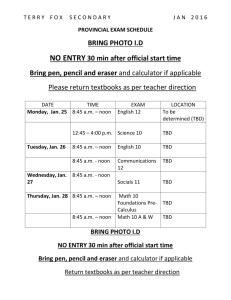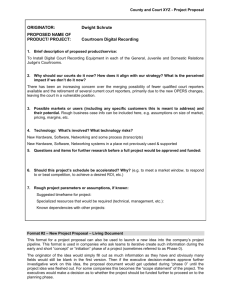4 System Quality Requirements
advertisement
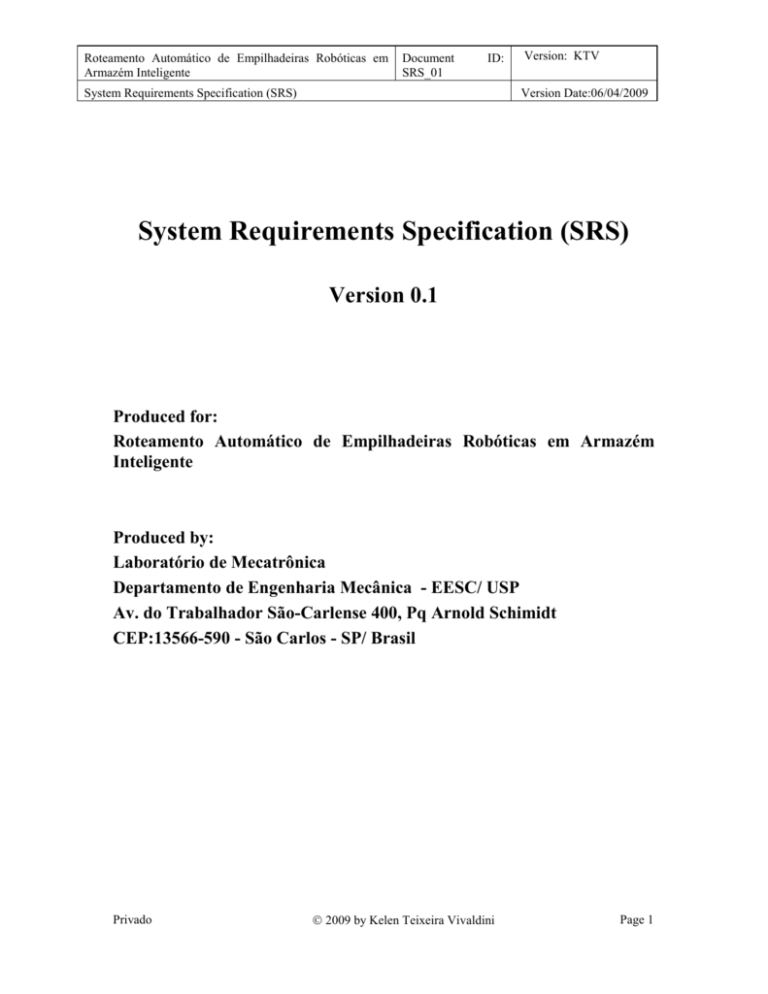
Roteamento Automático de Empilhadeiras Robóticas em Armazém Inteligente Document SRS_01 ID: System Requirements Specification (SRS) Version: KTV Version Date:06/04/2009 System Requirements Specification (SRS) Version 0.1 Produced for: Roteamento Automático de Empilhadeiras Robóticas em Armazém Inteligente Produced by: Laboratório de Mecatrônica Departamento de Engenharia Mecânica - EESC/ USP Av. do Trabalhador São-Carlense 400, Pq Arnold Schimidt CEP:13566-590 - São Carlos - SP/ Brasil Privado 2009 by Kelen Teixeira Vivaldini Page 1 Roteamento Automático de Empilhadeiras Robóticas em Armazém Inteligente Document SRS_01 ID: System Requirements Specification (SRS) Version: KTV Version Date:06/04/2009 Executive Overview O projeto visa desenvolver um algoritmo de roteamento para realizar a otimização de rotas em tempo-real, e que possa ser embarcada em empilhadeiras robóticas para uso em armazéns inteligentes. O objetivo para o projeto são: Demandas de AGVs para espaço restritos Melhorar o ganho de performance no calculo da melhor rota Após a inicialização do roteamento caso haja: o Imprevistos: recalcular a melhor rota e obter o mesmo desempenho o Novas tarefas: executá-las. Inclusão de múltiplos robôs. Analisar a possibilidade de simulações em ambientes 3D com geometrias complexas e pequenos espaços de manobra para as empilhadeiras. Privado 2009 by Kelen Teixeira Vivaldini Page 2 Roteamento Automático de Empilhadeiras Robóticas em Armazém Inteligente Document SRS_01 ID: System Requirements Specification (SRS) Version: KTV Version Date:06/04/2009 Revision History Date 06/04/2009 Privado Version Description 0.1 Author KTV 2009 by Kelen Teixeira Vivaldini Page 3 Roteamento Automático de Empilhadeiras Robóticas em Armazém Inteligente Document SRS_01 ID: System Requirements Specification (SRS) Version: KTV Version Date:06/04/2009 Table of Contents REVISION HISTORY ................................................................................................................................. 3 TABLE OF CONTENTS ............................................................................................................................. 4 INTRODUCTION ........................................................................................................................................ 8 2 3 1.1 DEFINITION ..................................................................................................................................... 8 1.2 SPECIFICATION OBJECTIVES ............................................................................................................ 8 1.3 INTENDED AUDIENCES .................................................................................................................... 8 1.4 REFERENCES ................................................................................................................................... 8 1.5 SPECIFICATION OVERVIEW .............................................................................................................. 9 SYSTEM OVERVIEW .......................................................................................................................10 2.1 SYSTEM DEFINITION .......................................................................................................................10 2.2 PRIMARY SYSTEM USAGE ..............................................................................................................10 2.3 <SYSTEM NAME> CONTEXT ...........................................................................................................10 2.3.1 Human Actors ........................................................................................................................10 2.3.2 External Data Repositories....................................................................................................10 2.3.3 External Hardware ................................................................................................................10 2.3.4 External Networks .................................................................................................................10 2.3.5 External Software ..................................................................................................................10 2.3.6 External Systems ....................................................................................................................10 SYSTEM OPERATIONAL REQUIREMENTS ..............................................................................11 3.1 EXTERNAL ACTORS ........................................................................................................................11 3.1.1 3.1.1.1 <External Actor Name> ........................................................................................................11 Essential Use Case: <Use Case Name> ............................................................................................ 11 3.1.1.1.1 3.2 <Normal/Exceptional> Path: <Path Name> ............................................................................... 12 EXTERNAL DATA REPOSITORIES ....................................................................................................13 3.2.1 3.2.1.1 <External Data Repository Name> .......................................................................................13 Essential Use Case: <Use Case Name> ............................................................................................ 13 3.2.1.1.1 3.3 <Normal/Exceptional> Path: <Path Name> ............................................................................... 13 EXTERNAL HARDWARE ..................................................................................................................14 3.3.1 3.3.1.1 <External Hardware Name> ................................................................................................14 Essential Use Case: <Use Case Name> ............................................................................................ 15 3.3.1.1.1 3.4 <Normal/Exceptional> Path: <Path Name> ............................................................................... 15 EXTERNAL NETWORKS ...................................................................................................................16 3.4.1 3.4.1.1 <External Network Name> ...................................................................................................16 Essential Use Case: <Use Case Name> ............................................................................................ 16 3.4.1.1.1 3.5 EXTERNAL SOFTWARE ...................................................................................................................18 3.5.1 Privado <Normal/Exceptional> Path: <Path Name> ............................................................................... 17 <External Application Name> ..............................................................................................18 2009 by Kelen Teixeira Vivaldini Page 4 Roteamento Automático de Empilhadeiras Robóticas em Armazém Inteligente Document SRS_01 ID: System Requirements Specification (SRS) 3.5.1.1 <Normal/Exceptional> Path: <Path Name> ............................................................................... 19 EXTERNAL SYSTEMS ......................................................................................................................19 3.6.1 3.6.1.1 <External System Name> ......................................................................................................20 Essential Use Case: <Use Case Name> ............................................................................................ 20 3.6.1.1.1 4 Version Date:06/04/2009 Essential Use Case: <Use Case Name> ............................................................................................ 18 3.5.1.1.1 3.6 Version: KTV <Normal/Exceptional> Path: <Path Name> ............................................................................... 20 SYSTEM QUALITY REQUIREMENTS .........................................................................................21 4.1 DEVELOPER-ORIENTED QUALITY REQUIREMENTS .........................................................................21 4.1.1 Installability ...........................................................................................................................21 4.1.2 Maintainability ......................................................................................................................21 4.1.2.1 Correctability ................................................................................................................................... 22 4.1.2.2 Extensibility ..................................................................................................................................... 22 4.1.3 Portability ..............................................................................................................................22 4.1.4 Reusability .............................................................................................................................22 4.1.5 Scalability ..............................................................................................................................22 4.1.6 Testability ..............................................................................................................................22 4.2 USER-ORIENTED QUALITY REQUIREMENTS ...................................................................................22 4.2.1 Accessibility ...........................................................................................................................22 4.2.2 Auditability ............................................................................................................................22 4.2.3 Configurability.......................................................................................................................22 4.2.3.1 Functional Variants .......................................................................................................................... 22 4.2.3.2 Internationalization .......................................................................................................................... 23 4.2.3.3 Personalization ................................................................................................................................. 23 4.2.4 Correctness ............................................................................................................................23 4.2.4.1 Allowable Latent Defects ................................................................................................................. 23 4.2.4.2 Accuracy .......................................................................................................................................... 24 4.2.4.3 Precision ........................................................................................................................................... 24 4.2.4.4 Timeliness ........................................................................................................................................ 24 4.2.5 Efficiency ...............................................................................................................................24 4.2.6 Interoperability ......................................................................................................................24 4.2.7 Operational Availability ........................................................................................................24 4.2.8 Performance ..........................................................................................................................24 4.2.8.1 Capacity ........................................................................................................................................... 24 4.2.8.2 Latency ............................................................................................................................................. 24 4.2.8.3 Response Time ................................................................................................................................. 24 4.2.8.4 Throughput ....................................................................................................................................... 25 4.2.9 Reliability ..............................................................................................................................25 4.2.10 Robustness .............................................................................................................................25 4.2.11 Safety .....................................................................................................................................25 4.2.12 Security ..................................................................................................................................25 4.2.12.1 Privado Identification ................................................................................................................................ 25 2009 by Kelen Teixeira Vivaldini Page 5 Roteamento Automático de Empilhadeiras Robóticas em Armazém Inteligente Document SRS_01 ID: System Requirements Specification (SRS) Authentication ............................................................................................................................. 25 4.2.12.3 Authorization ............................................................................................................................... 25 4.2.12.4 Immunity ..................................................................................................................................... 25 4.2.12.5 Privacy ......................................................................................................................................... 25 4.2.12.6 Integrity ....................................................................................................................................... 25 4.2.12.7 Intrusion Detection ...................................................................................................................... 25 4.2.12.8 Nonrepudiation ............................................................................................................................ 26 4.2.12.9 System Maintenance Security ...................................................................................................... 26 Usability ................................................................................................................................26 ARCHITECTURE AND DESIGN CONSTRAINTS .......................................................................27 5.1 BUSINESS RULES ............................................................................................................................27 5.2 DATA AND CONTENT CONSTRAINTS...............................................................................................27 5.2.1 5.3 6. Version Date:06/04/2009 4.2.12.2 4.2.13 5 Version: KTV Databases ..............................................................................................................................27 SOFTWARE CONSTRAINTS ..............................................................................................................27 5.3.1 Components ...........................................................................................................................27 5.3.2 High-Level Languages ...........................................................................................................27 5.4 HARDWARE CONSTRAINTS .............................................................................................................27 5.5 INDUSTRY STANDARDS ..................................................................................................................27 5.6 LEGAL AND REGULATORY CONSTRAINTS ......................................................................................28 ENVISIONED FUTURE ENHANCEMENTS .................................................................................28 APPENDICES .............................................................................................................................................28 A. OPEN ISSUES ..........................................................................................................................................28 B. MAJOR THINGS TO BE DONE .................................................................................................................28 C. ASSUMPTIONS ........................................................................................................................................28 Privado 2009 by Kelen Teixeira Vivaldini Page 6 Roteamento Automático de Empilhadeiras Robóticas em Armazém Inteligente Document SRS_01 ID: System Requirements Specification (SRS) Version: KTV Version Date:06/04/2009 Table of Figures Figure 1: <System Name> Context Diagram ................................................................................................10 Figure 2: <System Name> Summary Use Case Diagram ..............................................................................11 Figure 3: <Actor Name> Use Case Diagram .................................................................................................11 Figure 4: <Path Name> Sequence Diagram ..................................................................................................12 Figure 5: <External Data Repository Name> Use Case Diagram .................................................................13 Figure 6: <Path Name> Sequence Diagram ..................................................................................................14 Figure 7: <External Hardware Name> Use Case Diagram ............................................................................15 Figure 8: <Path Name> Sequence Diagram ..................................................................................................16 Figure 9: <Network Name> Use Case Diagram ............................................................................................16 Figure 10: <Path Name> Sequence Diagram ................................................................................................17 Figure 11: <External Software Name> Use Case Diagram ...........................................................................18 Figure 12: <Path Name> Sequence Diagram ................................................................................................19 Figure 13: <External System Name> Use Case Diagram ..............................................................................20 Figure 14: <Path Name> Sequence Diagram ................................................................................................21 Privado 2009 by Kelen Teixeira Vivaldini Page 7 Roteamento Automático de Empilhadeiras Robóticas em Armazém Inteligente Document SRS_01 ID: System Requirements Specification (SRS) Version: KTV Version Date:06/04/2009 1 Introduction A seção introduz a especificação de requisitos do sistema (SRS) para o Roteamento. 1.1 Definition Este documento específica formalmente os requisitos do Projeto. 1.2 Specification Objectives This system requirements specification has the following objectives: To provide an overview of the application’s context and capabilities. To formally specify the associated: Operational requirements. Informational requirements. Quality requirements. Architecture and Design constraints. To document any future planned enhancements. To document any open issues, major things to be completed, and assumptions.” 1.3 Intended Audiences This system requirements specification has the following intended audiences: Architecture Team, which uses it to drive and validate the system architectures. Customer Organization, which uses it to understand the scope of the application to be delivered. Hardware Development Team, which uses it to drive the design of the hardware components. Independent Test Team, which uses it to generate system and launch tests. Metrics Team, which uses the requirements in it to estimate the size and scope of the endeavor. Management Team, which uses it to manage project scope and schedule project activities. Software Development Team, which uses it to drive the design of the software components. Subcontractor Organizations, which use it to drive their work. User Experience Team, which uses it to drive and validate the human interface prototype. User Support Team, which uses its operational requirements as input to the users manual and user support materials. 1.4 References This SRS references or must be consistent with the following documents: Customer Documents: Endeavor Documents: Application Vision Statement Project Glossary Development Organization Documents: Privado TBD System Requirements Specification Content and Format Specification 2009 by Kelen Teixeira Vivaldini Page 8 Roteamento Automático de Empilhadeiras Robóticas em Armazém Inteligente Document SRS_01 ID: System Requirements Specification (SRS) 1.5 Version: KTV Version Date:06/04/2009 System Requirements Specification Template System Requirements Specification Inspection Checklist Specification Overview This SRS is organized into the following sections: Introduction, which introduces the system requirements specification (SRS) for <System Name> to its readers. System Overview, which provides a high level description of the <System Name> system including its definition, functions, context, and typical usage. System Operational Requirements, which specifies the system’s operational (a.k.a., functional) requirements in terms of a use case model consisting of each external’s use cases and use case paths. System Quality Requirements, which specifies the required system’s quality factors that are not related to the specific operational requirements. Architecture and Design Constraints, which specifies required architecture and design constraints to be treated as requirements. Appendices, which defines ancillary information including open issues and TBDs, etc. Privado 2009 by Kelen Teixeira Vivaldini Page 9 Roteamento Automático de Empilhadeiras Robóticas em Armazém Inteligente Document SRS_01 ID: System Requirements Specification (SRS) Version: KTV Version Date:06/04/2009 2 System Overview This provides a high level description of system including its usage and context. 2.1 System Definition <System Name> is TBD. 2.2 Primary System Usage <System Name> is typically used as follows. TBD 2.3 TBD <System Name> Context The subsection uses context diagrams to document the context of the <System Name> system in terms of the external actors, data repositories, hardware, networks, software, and systems with which it interacts. TBD Figure 1: <System Name> Context Diagram 2.3.1 Human Actors <System Name> system interacts, either directly or indirectly, with the following significant human actors (roles, teams, and organizations): TBD 2.3.2 External Data Repositories <System Name> system interacts, either directly or indirectly, with the following significant external data repositories: TBD 2.3.3 External Hardware <System Name> system interacts, either directly or indirectly, with the following significant external hardware: TBD 2.3.4 External Networks <System Name> system interacts, either directly or indirectly, with the following significant external networks: TBD 2.3.5 External Software <System Name> system interacts, either directly or indirectly, with the following significant external software: TBD 2.3.6 External Systems <System Name> system interacts, either directly or indirectly, with the following significant external systems: Privado 2009 by Kelen Teixeira Vivaldini Page 10 Roteamento Automático de Empilhadeiras Robóticas em Armazém Inteligente Document SRS_01 ID: System Requirements Specification (SRS) Version: KTV Version Date:06/04/2009 TBD 3 Functional Requirements A seção de SRS especifica os requisitos funcionais do Sistema de Roteamento em termos de um modelo de caso de uso que consiste em casos de uso. TBD Figure 2: <System Name> Summary Use Case Diagram 3.1 External Actors This subsection describes and specifies external actors (human actors, teams, and organizations), the associated externals, and all use cases primarily driven by these externals. 3.1.1 <External Actor Name> The subsection specifies the operational requirements primarily concerning <External Actor Name>. Definition <A brief narrative English definition of the actor> Responsibilities <Actor Name> has the following responsibilities: • TBD Required Capabilities <Actor Name> needs the following required technical expertise, experience, and training to effectively interact with <System Name>: • TBD Use Case Diagram TBD Figure 3: <Actor Name> Use Case Diagram Use Cases <Use Case 1 Name> <Use Case 2 Name> 3.1.1.1 Essential Use Case: <Use Case Name> Use Case Requirement The system shall TBD. Business Justification • TBD Preconditions • TBD Use Case Paths Privado Normal: 2009 by Kelen Teixeira Vivaldini Page 11 Roteamento Automático de Empilhadeiras Robóticas em Armazém Inteligente Document SRS_01 ID: System Requirements Specification (SRS) Version: KTV Version Date:06/04/2009 <Normal Path Name> Exceptional: <Exceptional Path Name> 3.1.1.1.1 <Normal/Exceptional> Path: <Path Name> Path Requirement The system shall TBD. Externals • Clients: • Peers: • TBD TBD Servers: TBD Preconditions • TBD Interactions 1. <External Name> sends a <interaction name> [request | query] containing the following information to the <System Name>: 2. <System Name> shall send a <interaction name> response containing the following information to the <External Name>: 3. TBD TBD <System Name> shall send a <interaction name> event notification containing the following information to the <External Name>: TBD Blackbox Sequence Diagram TBD Figure 4: <Path Name> Sequence Diagram Postconditions • TBD Requirements Trace • TBD Risk Factors • • • • Privado Volatility: [High | Medium | Low] Frequency: [High | Medium | Low] <Average/maximum number of times a day/second> Criticality: [High | Medium | Low] Probability of Defects: [High | Medium | Low] 2009 by Kelen Teixeira Vivaldini Page 12 Roteamento Automático de Empilhadeiras Robóticas em Armazém Inteligente Document SRS_01 ID: System Requirements Specification (SRS) • 3.2 Version: KTV Version Date:06/04/2009 Risk: [High | Medium | Low] External Data Repositories The subsection specifies the operational requirements primarily concerning <External Application Name>. 3.2.1 <External Data Repository Name> The subsection specifies the operational requirements primarily concerning <External Data Repository Name>. Definition <A brief narrative English definition of the external data repository> Responsibilities <External Data Repository Name> has the following responsibilities: • TBD Use Case Diagram TBD Figure 5: <External Data Repository Name> Use Case Diagram Use Cases <Use Case 1 Name> <Use Case 2 Name> 3.2.1.1 Essential Use Case: <Use Case Name> Use Case Requirement The system shall TBD. Business Justification • TBD Preconditions • TBD Use Case Paths Normal: <Normal Path Name> Exceptional: <Exceptional Path Name> 3.2.1.1.1 <Normal/Exceptional> Path: <Path Name> Path Requirement The system shall TBD. Externals • Clients: • Privado TBD Peers: 2009 by Kelen Teixeira Vivaldini Page 13 Roteamento Automático de Empilhadeiras Robóticas em Armazém Inteligente Document SRS_01 ID: System Requirements Specification (SRS) • Version: KTV Version Date:06/04/2009 TBD Servers: TBD Preconditions • TBD Interactions 1. <External Name> sends a <interaction name> [request | query] containing the following information to the <System Name>: 2. TBD <System Name> shall send a <interaction name> response containing the following information to the <External Name>: 3. TBD <System Name> shall send a <interaction name> event notification containing the following information to the <External Name>: TBD Blackbox Sequence Diagram TBD Figure 6: <Path Name> Sequence Diagram Postconditions • TBD Requirements Trace • TBD Risk Factors • • • • • 3.3 Volatility: [High | Medium | Low] Frequency: [High | Medium | Low] <Average/maximum number of times a day/second> Criticality: [High | Medium | Low] Probability of Defects: [High | Medium | Low] Risk: [High | Medium | Low] External Hardware The subsection specifies the operational requirements primarily concerning <External Hardware Name>. 3.3.1 <External Hardware Name> The subsection specifies the operational requirements primarily concerning <External Hardware Name>. Definition <A brief narrative English definition of the external hardware> Responsibilities <External Hardware Name> has the following responsibilities: • Privado TBD 2009 by Kelen Teixeira Vivaldini Page 14 Roteamento Automático de Empilhadeiras Robóticas em Armazém Inteligente Document SRS_01 ID: System Requirements Specification (SRS) Version: KTV Version Date:06/04/2009 Use Case Diagram TBD Figure 7: <External Hardware Name> Use Case Diagram Use Cases <Use Case 1 Name> <Use Case 2 Name> 3.3.1.1 Essential Use Case: <Use Case Name> Use Case Requirement The system shall TBD. Business Justification • TBD Preconditions • TBD Use Case Paths Normal: <Normal Path Name> Exceptional: <Exceptional Path Name> 3.3.1.1.1 <Normal/Exceptional> Path: <Path Name> Path Requirement The system shall TBD. Externals • Clients: • Peers: • TBD TBD Servers: TBD Preconditions • TBD Interactions 1. <External Name> sends a <interaction name> [request | query] containing the following information to the <System Name>: 2. <System Name> shall send a <interaction name> response containing the following information to the <External Name>: Privado TBD TBD 2009 by Kelen Teixeira Vivaldini Page 15 Roteamento Automático de Empilhadeiras Robóticas em Armazém Inteligente Document SRS_01 ID: System Requirements Specification (SRS) 3. Version: KTV Version Date:06/04/2009 <System Name> shall send a <interaction name> event notification containing the following information to the <External Name>: TBD Blackbox Sequence Diagram TBD Figure 8: <Path Name> Sequence Diagram Postconditions • TBD Requirements Trace • TBD Risk Factors • • • • • 3.4 Volatility: [High | Medium | Low] Frequency: [High | Medium | Low] <Average/maximum number of times a day/second> Criticality: [High | Medium | Low] Probability of Defects: [High | Medium | Low] Risk: [High | Medium | Low] External Networks This subsection describes and specifies external networks and all use cases primarily driven by these externals. 3.4.1 <External Network Name> The subsection specifies the operational requirements primarily concerning <External Network Name>. Definition <A brief narrative English definition of the network> Responsibilities <Network Name> has the following responsibilities: • TBD Use Case Diagram TBD Figure 9: <Network Name> Use Case Diagram Use Cases <Use Case 1 Name> <Use Case 2 Name> 3.4.1.1 Essential Use Case: <Use Case Name> Use Case Requirement The system shall TBD. Privado 2009 by Kelen Teixeira Vivaldini Page 16 Roteamento Automático de Empilhadeiras Robóticas em Armazém Inteligente Document SRS_01 ID: System Requirements Specification (SRS) Version: KTV Version Date:06/04/2009 Business Justification • TBD Preconditions • TBD Use Case Paths Normal: <Normal Path Name> Exceptional: <Exceptional Path Name> 3.4.1.1.1 <Normal/Exceptional> Path: <Path Name> Path Requirement The system shall TBD. Externals • Clients: • Peers: • TBD TBD Servers: TBD Preconditions • TBD Interactions 4. <External Name> sends a <interaction name> [request | query] containing the following information to the <System Name>: 5. <System Name> shall send a <interaction name> response containing the following information to the <External Name>: 6. TBD TBD <System Name> shall send a <interaction name> event notification containing the following information to the <External Name>: TBD Blackbox Sequence Diagram TBD Figure 10: <Path Name> Sequence Diagram Postconditions • Privado TBD 2009 by Kelen Teixeira Vivaldini Page 17 Roteamento Automático de Empilhadeiras Robóticas em Armazém Inteligente Document SRS_01 ID: System Requirements Specification (SRS) Version: KTV Version Date:06/04/2009 Requirements Trace • TBD Risk Factors • • • • • 3.5 Volatility: [High | Medium | Low] Frequency: [High | Medium | Low] <Average/maximum number of times a day/second> Criticality: [High | Medium | Low] Probability of Defects: [High | Medium | Low] Risk: [High | Medium | Low] External Software The subsection specifies the operational requirements primarily concerning external software. 3.5.1 <External Application Name> The subsection specifies the operational requirements primarily concerning <External Software Name>. Definition <A brief narrative English definition of the external software> Responsibilities <External Software Name> has the following responsibilities: • TBD Use Case Diagram TBD Figure 11: <External Software Name> Use Case Diagram Use Cases <Use Case 1 Name> <Use Case 2 Name> 3.5.1.1 Essential Use Case: <Use Case Name> Use Case Requirement The system shall TBD. Business Justification • TBD Preconditions • TBD Use Case Paths Normal: Exceptional: Privado <Normal Path Name> <Exceptional Path Name> 2009 by Kelen Teixeira Vivaldini Page 18 Roteamento Automático de Empilhadeiras Robóticas em Armazém Inteligente Document SRS_01 ID: System Requirements Specification (SRS) Version: KTV Version Date:06/04/2009 3.5.1.1.1 <Normal/Exceptional> Path: <Path Name> Path Requirement The system shall TBD. Externals • Clients: • TBD Peers: • TBD Servers: TBD Preconditions • TBD Interactions 1. <External Name> sends a <interaction name> [request | query] containing the following information to the <System Name>: 2. TBD <System Name> shall send a <interaction name> response containing the following information to the <External Name>: 3. TBD <System Name> shall send a <interaction name> event notification containing the following information to the <External Name>: TBD Blackbox Sequence Diagram TBD Figure 12: <Path Name> Sequence Diagram Postconditions • TBD Requirements Trace • TBD Risk Factors • • • • • 3.6 Volatility: [High | Medium | Low] Frequency: [High | Medium | Low] <Average/maximum number of times a day/second> Criticality: [High | Medium | Low] Probability of Defects: [High | Medium | Low] Risk: [High | Medium | Low] External Systems The subsection specifies the operational requirements primarily concerning external systems. Privado 2009 by Kelen Teixeira Vivaldini Page 19 Roteamento Automático de Empilhadeiras Robóticas em Armazém Inteligente Document SRS_01 ID: System Requirements Specification (SRS) Version: KTV Version Date:06/04/2009 3.6.1 <External System Name> The subsection specifies the operational requirements primarily concerning <External System Name>. Definition <A brief narrative English definition of the external system> Responsibilities <External Organization Name> has the following responsibilities: • TBD Use Case Diagram TBD Figure 13: <External System Name> Use Case Diagram Use Cases <Use Case 1 Name> <Use Case 2 Name> 3.6.1.1 Essential Use Case: <Use Case Name> Use Case Requirement The system shall TBD. Business Justification • TBD Preconditions • TBD Use Case Paths Normal: <Normal Path Name> Exceptional: <Exceptional Path Name> 3.6.1.1.1 <Normal/Exceptional> Path: <Path Name> Path Requirement The system shall TBD. Externals • Clients: • Peers: • TBD Servers: Privado TBD TBD 2009 by Kelen Teixeira Vivaldini Page 20 Roteamento Automático de Empilhadeiras Robóticas em Armazém Inteligente Document SRS_01 ID: System Requirements Specification (SRS) Version: KTV Version Date:06/04/2009 Preconditions • TBD Interactions 1. <External Name> sends a <interaction name> [request | query] containing the following information to the <System Name>: 2. TBD <System Name> shall send a <interaction name> response containing the following information to the <External Name>: 3. TBD <System Name> shall send a <interaction name> event notification containing the following information to the <External Name>: TBD Blackbox Sequence Diagram TBD Figure 14: <Path Name> Sequence Diagram Postconditions • TBD Requirements Trace • TBD Risk Factors • • • • • Volatility: [High | Medium | Low] Frequency: [High | Medium | Low] <Average/maximum number of times a day/second> Criticality: [High | Medium | Low] Probability of Defects: [High | Medium | Low] Risk: [High | Medium | Low] 4 System Quality Requirements This section specifies the required system quality factors that are not related to the specific operational requirements documented in the use case model. 4.1 Developer-Oriented Quality Requirements This subsection specifies all developer-oriented quality requirements: 4.1.1 Installability This subsection specifies the following requirements concerning the installability of the application: 1. TBD 4.1.2 Maintainability This subsection specifies the following requirements concerning the maintainability of the application: Privado 2009 by Kelen Teixeira Vivaldini Page 21 Roteamento Automático de Empilhadeiras Robóticas em Armazém Inteligente Document SRS_01 ID: System Requirements Specification (SRS) Version: KTV Version Date:06/04/2009 4.1.2.1 Correctability This subsection specifies the following requirements concerning the correctability of the application: 4. TBD 4.1.2.2 Extensibility This subsection specifies the following requirements concerning the extensibility of the application: 1. TBD 4.1.3 Portability This subsection specifies the following requirements concerning the portability of the application: 2. TBD 4.1.4 Reusability This subsection specifies the following requirements concerning the reusability of the application: 3. TBD 4.1.5 Scalability This subsection specifies the following requirements concerning the scalability of the application: 4. TBD 4.1.6 Testability This subsection specifies the following requirements concerning the testability of the application: 5. 4.2 TBD User-Oriented Quality Requirements This subsection specifies all user-oriented quality requirements: 4.2.1 Accessibility This subsection specifies the following requirements concerning the degree to which the system must be accessible to use by people with disabilities: SYSQR-ACC-1) TBD 4.2.2 Auditability This subsection specifies the following requirements concerning the degree to which the system must support independent audits of its financials and transactions: SYSQR-AUD-1) TBD 4.2.3 Configurability This subsection specifies the following requirements concerning the degree to which the system must be configurable into multiple variants. 4.2.3.1 Functional Variants This subsection specifies the following requirements concerning the need for the system to exist in multiple variants that provide different sets of capabilities: Privado SYSQR-CON-1) TBD 2009 by Kelen Teixeira Vivaldini Page 22 Roteamento Automático de Empilhadeiras Robóticas em Armazém Inteligente Document SRS_01 Version: KTV ID: System Requirements Specification (SRS) Version Date:06/04/2009 4.2.3.2 Internationalization This subsection specifies the following requirements concerning the degree to which the system must function in a global marketplace: 5. The application shall be internationalized for the following countries: TBD. 6. The application shall be internationalized for the following native languages and dialects of the target countries: TBD. 7. The application shall properly handle multibyte character sets (MBCS) for the official languages of the target countries (e.g., using Unicode ISO-10646). 8. The application shall use target country and language conventions for: Calendars (e.g., Japan, Korea, and Islamic countries), date formatting (e.g., Europe vs. USA), and time formatting (e.g., 12 hour vs. 24 hour clock). Currency formatting (e.g., currency symbol, fractional currency, and number of digits). Cultural norms (e.g., avoidance of specific colors, numbers, graphics, and words). Line breaks and hyphenation. Names (e.g., number, order, honorifics, and suffixes). Numbers: Chinese ideographic characters for numbers in financial documents. National identity numbers (e.g., social security number). Sorting of lists. Legal issues such as: 5. Import/export laws. Tariff and sales tax calculations. Customs documentation. Trademarks. Privacy laws. Text directions (e.g., left to right, right to left, top to bottom). Internationalization shall not require changes to executable software component including user interfaces. 4.2.3.3 Personalization This subsection specifies the following requirements concerning degree to which the system configures itself to provide a tailored experience (i.e., look and feel) to different individual users: SYSQR-CON-TBD) TBD 4.2.4 Correctness This subsection specifies the following requirements concerning the degree to which the system must ensure that its information is correct. 4.2.4.1 Allowable Latent Defects This subsection specifies the following requirements concerning the maximum number of allowable latent defects of each severity in released work products: Privado SYSQR-COR-1) TBD 2009 by Kelen Teixeira Vivaldini Page 23 Roteamento Automático de Empilhadeiras Robóticas em Armazém Inteligente Document SRS_01 ID: System Requirements Specification (SRS) Version: KTV Version Date:06/04/2009 4.2.4.2 Accuracy This subsection specifies the following requirements concerning with degree of correctness of the system’s outputs: SYSQR-COR-TBD) TBD 4.2.4.3 Precision This subsection specifies the following requirements concerning the resolution of the system’s numerical outputs: SYSQR-COR-TBD) TBD 4.2.4.4 Timeliness This subsection specifies the following requirements concerning the degree to which the system must ensure that its persistent information is current (i.e., up-to-date): SYSQR- COR-TBD) TBD 4.2.5 Efficiency This subsection specifies the following requirements concerning the degree to which the system effectively uses its resources (e.g., processor, RAM, and memory): SYSQR-EFF-1) TBD 4.2.6 Interoperability This subsection specifies all requirements and goals concerning the degree to (or ease with which) the system can be integrated with other system (e.g., legacy applications and required databases): SYSQR-IOP-1) TBD 4.2.7 Operational Availability This subsection specifies the following requirements concerning the percent of time that the system must function without planned or unplanned downtime from the viewpoints of different user types or client applications: SYSQR-OA-1) TBD 4.2.8 Performance This subsection specifies the following requirements concerning the performance of the system: 4.2.8.1 Capacity This subsection specifies the following requirements concerning the minimum number of objects that the system can support: SYSQR-PER-1) TBD 4.2.8.2 Latency This subsection specifies the following requirements concerning the maximum time that is permitted for the system to execute specific tasks (i.e., system operations) or use case paths end to end: SYSQR-PER-TBD) TBD 4.2.8.3 Response Time This subsection specifies the following requirements concerning the maximum time that is permitted for the system to respond to specific requests: Privado 2009 by Kelen Teixeira Vivaldini Page 24 Roteamento Automático de Empilhadeiras Robóticas em Armazém Inteligente Document SRS_01 ID: System Requirements Specification (SRS) Version: KTV Version Date:06/04/2009 SYSQR-PER-TBD) TBD 4.2.8.4 Throughput This subsection specifies the following requirements concerning how many executions of a given system operation or use case path must the system be able execute in a unit of time: SYSQR-PER-TBD) TBD 4.2.9 Reliability This subsection specifies the following requirements concerning the reliability (e.g., mean time between failures, number of failures per unit time) of the system: SYSQR-REL-1) TBD 4.2.10 Robustness This subsection specifies the following requirements concerning the degree to which the system continues to properly function under abnormal circumstances (e.g., invalid inputs, failure of software or hardware components, and failure of applications on which it depends): SYSQR-ROB-1) TBD 4.2.11 Safety This subsection specifies the following requirements concerning the degree to which the system does not directly or indirectly (e.g., via inactivity) cause accidental harm to life or property (e.g., loss of money or data): SYSQR-SAF-1) TBD 4.2.12 Security This subsection specifies the following requirements (not already captured in the use case model) that are concerning the degree to which system protects itself from unauthorized access or modification: 4.2.12.1 Identification SYSQR-SEC-1) TBD 4.2.12.2 Authentication SYSQR-SEC-TBD) TBD 4.2.12.3 Authorization SYSQR-SEC-TBD) TBD 4.2.12.4 Immunity SYSQR-SEC-TBD) TBD 4.2.12.5 Privacy SYSQR-SEC-TBD) TBD 4.2.12.6 Integrity SYSQR-SEC-TBD) TBD 4.2.12.7 Intrusion Detection Privado SYSQR-SEC-TBD) TBD 2009 by Kelen Teixeira Vivaldini Page 25 Roteamento Automático de Empilhadeiras Robóticas em Armazém Inteligente Document SRS_01 ID: System Requirements Specification (SRS) Version: KTV Version Date:06/04/2009 4.2.12.8 Nonrepudiation SYSQR-SEC-TBD) TBD 4.2.12.9 System Maintenance Security SYSQR-SEC-TBD) TBD 4.2.13 Usability This subsection specifies the following requirements concerning the ease with which the system can be used. Privado SYSQR-USE-1) TBD 2009 by Kelen Teixeira Vivaldini Page 26 Roteamento Automático de Empilhadeiras Robóticas em Armazém Inteligente Document SRS_01 ID: System Requirements Specification (SRS) Version: KTV Version Date:06/04/2009 5 Architecture and Design Constraints The section documents the major architecture and design constraints on the system. 5.1 Business Rules The subsection documents all relevant business rules. 5.2 Data and Content Constraints The subsection documents all required data (i.e., content) constraints. 5.2.1 Databases The subsection documents all required design constraints concerning the use of databases: 5.3 SYSDC-DB-1) TBD Software Constraints The subsection documents all required software constraints. 5.3.1 Components The subsection documents all required design constraints concerning the use of components: SYSDC-COM-1) TBD 5.3.2 High-Level Languages The subsection documents all required design constraints concerning the use of high-level programming languages: 5.4 SYSDC-HLL-1) TBD Hardware Constraints The subsection documents all required design constraints concerning minimum or actual hardware. TBD 5.5 Industry Standards The subsection documents all required design constraints concerning compliance with industry standards: DC-STD-1) The system shall conform to ISO 10646 (Unicode UTF-8) and ISO 10646-1 (Unicode UTF16) standards for character set encoding. www.unicode.org ftp.informatik.uni-erlangen.de/pub/doc/ISO/charsets/ISO-10646-UTF-8.html ftp.informatik.uni-erlangen.de/pub/doc/ISO/charsets/ISO-10646-UTF-16.html DC-STD-2) The system shall conform to ISO 4217, codes for the representation of currencies. www.xe.net/gen/iso4217.htm DC-STD-3) The system shall conform to ISO 31, codes for units of measure. www.unece.org/trade/rec/rec20en.htm DC-STD-4) The system shall conform to ISO639-1 Languages, codes for the representation of languages. http://sunsite.berkeley.edu/amher/iso_639.html DC-STD-5) The system shall conform to ISO 3166-1, codes for the representation of names of countries. Privado www.din.de/gremien/nas/nabd/iso3166ma/codlstp1/index.html 2009 by Kelen Teixeira Vivaldini Page 27 Roteamento Automático de Empilhadeiras Robóticas em Armazém Inteligente Document SRS_01 ID: System Requirements Specification (SRS) Version: KTV Version Date:06/04/2009 DC-STD-6) The system shall conform to ISO 8601, representation of dates and times. 5.6 www.state.ak.us/local/akpages/ADMIN/info/iso8601.htm Legal and Regulatory Constraints The subsection documents all required design constraints concerning compliance with legal and regulatory constraints: 6. Envisioned Future Enhancements The section documents the following envisioned future enhancements: Appendices The section documents the following appendices: Open Issues Major Things To Be Done Assumptions A. Open Issues This appendix documents the following open issues to be resolved: TBD B. Major Things To Be Done This appendix documents the following major things that have not yet been completed: TBD C. Assumptions This appendix documents the following assumptions behind the requirements: Privado TBD 2009 by Kelen Teixeira Vivaldini Page 28

